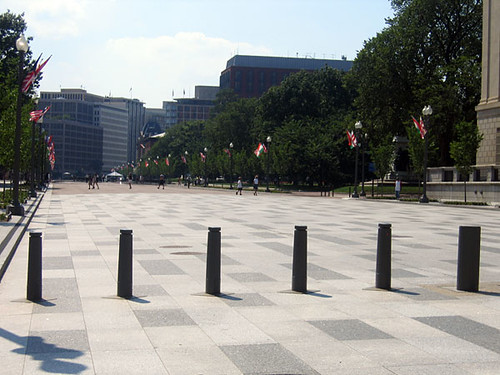Building security, the federal city, and disconnecting democracy
Over the years I have written from time to time about federal and local government buildings and security procedures required for getting into those buildings, as well as the ever increasing restrictions on road access to certain areas such as in Capitol Hill (including proposals to shut down 2nd Street to extend the security perimeter for the U.S. Capitol and the Supreme Court) and the White House. (For at least 6 years now, during the State of the Union address, in the last few years, many of the access roads around the U.S. Capitol are blocked off by parking Metrobuses across the intersections, in advance of the speech.)
Security concerns have transformed Washington, taking a city envisioned as the physical embodiment of the openness of American democracy and turning it into a garrison town that is increasingly inaccessible to the general public. To take one example, tourists visiting Capitol Hill start their trips by passing through a gauntlet of metal detectors and other screening measures in a $621 million visitors center constructed specifically to better protect what is already one of the most heavily guarded areas of the city.
The security creep that's a hallmark of life in today’s Washington has an obvious cause: The nation faces real and continuing threats from both professional terror groups like al-Qaida and homegrown -- and often mentally unbalanced -- solo assailants like Russell Eugene Weston Jr., who killed a pair of Capitol police officers in 1998. Pennsylvania Avenue was closed off in 1995 after Timothy McVeigh used a truck bomb to demolish a federal building in Oklahoma City, killing 168 people. The September 11 terrorist attacks sparked an even larger series of changes, with security personnel building new screening facilities and roadblocks outside buildings ranging from the Washington Monument to the World Bank.
The other day I came across a report from the Rowntree Foundation on civic participation in the UK, Do policies to promote community participation in governance build social capital?
The report distinguishes between might we might call rote "participating" which is how I feel about about many public meetings and processes, which aren't much more than dog and pony shows designed to be able to satisfy, without substance, public participation requirements, and building social capital and civic capacity. Some of the conclusions of the report are:
The key factor influencing levels of participation in governance was the existing pattern of 'linking' social capital: those already well-connected tend to get better connected.
Community participation tends to be dominated by a small group of insiders who are disproportionately involved in a large number of governance activities.
What social capital is created by opening up governance to community involvement tends to be concentrated in the hands of this small group. There is no guarantee that the wider community feels the benefit of this social capital, because formal governance structures are often not embedded in everyday community life.
The trick then it to redesign government and community engagement processes so that they provide the opportunity for significant substance.
Labels: civic engagement, democracy, participatory democracy and empowered participation, public safety, urban design/placemaking




0 Comments:
Post a Comment
<< Home